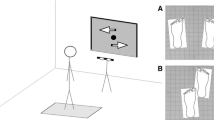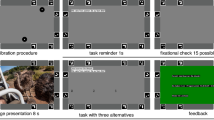Summary
Postural responses were measured for observers instructed to maintain an erect position when viewing a visual scene, which simulated motion of the observer relative to a corridor with texture on the walls. Both the direction and amplitude of the postural responses appeared to depend on the fixation direction of the observer. This result indicates that postural responses are not invariant with respect to fixation direction. Our results suggest that not one of the frequently suggested features in the optical flow in particular is used to maintain posture but rather that a combination of several optical flow components, that have been suggested in the literature, is relevant.
Similar content being viewed by others
References
Asten WNJC van, Gielen CCAM, Denier van der Gon JJ (1988a) Postural movements induced by rotations of visual scenes. JOSA A 5:1781–1789
Asten WNJC van, Gielen CCAM, Denier van der Gon JJ (1988b) Postural adjustments induced by simulated motion of differently structured environments. Exp Brain Res 73:371–383
Clement G, Pozzo T, Berthoz A (1988) Contribution of eye positioning to control of the upside-down standing posture. Exp Brain Res 73:569–576
Dichgans J, Brandt T (1978) Visual-vestibular interaction: effects on self-motion perception and postural control. In: Held R, Leibowitz H, Teuber H (eds) Handbook of sensory physiology, Vol 8. Springer, Berlin Heidelberg New York, pp 755–804
Diener HC, Dichgans J, Guschlbauer B, Bacher M (1986) Role of visual and and static vestibular influences on dynamic posture control. Hum Neurobiol 5:105–113
Gibson JJ (1950) The ecological approach to visual perception. Houghton-Mifflin, Boston
Ishida A, Imai S (1980) Responses of the posture-control system to pseudo-random acceleration disturbances. Med Biol Eng Comput 18:433–438
Jenkins G, Watts D (1968) Spectral analysis and its applications. Holden Day, San Francisco CA
Kapteyn TS, Bles W, Brandt Th, Wist ER (1979) Visual stabilization of posture: effect of light intensity and stroboscopic surround illumination. Agressologie 20C: 191–192
Koenderink JJ, van Dorn AJ (1976) Local structure of movement parallax of the plane. J Opt Soc Am 66:717–723
Koenderink JJ, van Dorn AJ (1981) Exterospecific component of the motion parallax field. J Opt Soc Am 71:953–957
Krauth J (1988) Distribution-free statistics: an application-oriented approach. Elsevier, Amsterdam
Ono ME, Rivest J, Ono H (1986) Depth perception as a function of motion parallax and absolute distance information. J Exp Psychol 12:331–337
Rauschecker JP, von Grunau MW, Poulin C (1987) Centrifugal organization of direction preferences in the cat's lateral supersylvian visual cortex and its relation to flow field processing. J Neurosci 7:943–958
Regan D, Beverley KI (1978) Looming detectors in the human visual pathway. Vision Res 18:415–421
Regan D, Beverley KI (1982) How do we avoid confounding the direction we are looking and the direction we are moving? Science 215:194–197
Regan D, Beverley KI (1985) Visual responses to vorticity and the neural analysis of optic flow. J Opt Soc Am [A] 2:280–283
Regan D, Beverley KI (1986) Visual processing of four kinds of relative motion. Vision Res 26:127–145
Rogers BJ, Graham ME (1983) Anisotropies in the perception of three-dimensional surfaces. Science 221:1409–1411
Saito HA, Yukie M, Tanaka K, Hikosaka K, Fukada Y, Iwai E (1986) Integration of direction signals of image motion in the superior temporal sulcus of the macaque monkey. J Neurosci 6:145–157
Stoffregen TA (1985) Flow structure versus retinal location in the optical control of stance. J Exp Psychol: Hum Perc & Perf 11:554–565
Stoffregen TA (1986) The role of optical velocity in the control of stance. Percept & Psychophys 39:355–360
Tanaka K, Hikosaka K, Saito H-A, Yukie M, Fukada Y, Iwai E (1986) Analysis of local and wide-field movements in the superior temporal visual areas of the macaque monkey. J Neurosci 6:134–144
Warren WH Jr, Morris MW, Kalish M (1988) Perception of translational heading from optical flow. J Exp Psychol: Hum Perc & Perf 14:646–660
Author information
Authors and Affiliations
Rights and permissions
About this article
Cite this article
Gielen, C.C.A.M., van Asten, W.N.J.C. Postural responses to simulated moving environments are not invariant for the direction of gaze. Exp Brain Res 79, 167–174 (1990). https://doi.org/10.1007/BF00228886
Received:
Accepted:
Issue Date:
DOI: https://doi.org/10.1007/BF00228886




